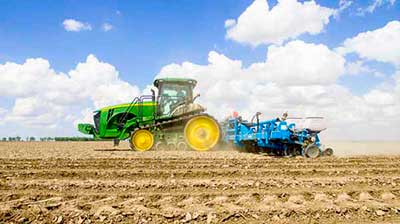Relevance: GS-1: Geographical features and their location-changes in critical geographical features (including water-bodies and ice-caps) and in flora and fauna and the effects of such changes.
Key phrases: Cropland, Deforestation
Why in news?
- Half of global cropland expansion replaced natural vegetation and tree cover
Analysis:
What is Deforestation?
- Deforestation is a very broad term, which consists of cutting of trees including repeated lopping, felling, and removal of forest litter, browsing, grazing, and trampling of seedlings
- It can also be defined as the removal or damage of vegetation in a forest to the extent that it no longer supports its natural flora and fauna.
Why are Forests Important?
- Around 1.6 billion people including more than 2,000 indigenous cultures depend on forests for their livelihoods, medicines, fuel, food and shelter.
- IPCC in fifth assessment report- fossil fuel emissions pump 9.9gt carbon annually, land change 1.5 GT but terrestrial ecosystems absorb 3.8 GT.
- Recycle moisture from soil which comes as rain-water lost as rapid run off Approximately 30% of the world’s fresh water supply can be sourced to tropical rainforests
- Forests provide US$ 75–100 billion per year in goods and services such as clean water and healthy soils.
- Deforestation and human health with man wild coming closer and emergence of more zoonotic diseases like corona.
What is Impact of Deforestation?
- Loss of trees results in an increasing amount of carbon dioxide in the atmosphere, which, being a greenhouse gas, enhances global warming.
- Deforestation also leads to desertification in plains and landslides in hilly areas.
- There is a loss of biodiversity of plants and animals as the wildlife species lose their natural habitat. Forests are the repositories of invaluable gifts of nature in the form of biodiversity, and by destroying these, we will lose many species even before knowing them.
- The water cycle is also affected by deforestation. Trees extract groundwater through their roots and release it into the atmosphere. When part of a forest is removed, the trees no longer transpire this water, resulting in a much drier climate.
- Increase in the rate of soil erosion. This can further lead to flooding in rivers and makes the soil susceptible to landslides.
- A short-term economic gain made by conversion of forest to agriculture, or overexploitation of wood products, typically leads to a loss of long-term income and long-term biological productivity.
Reasons behind Deforestation
- Agriculture: As per UNFCCC, agriculture is the direct cause of deforestation. Subsistence farming, commercial agriculture, shifting cultivation and industrial logging all cause deforestation.
- Developmental Projects like hydroelectric projects, reservoirs etc. require immense deforestation.
- Firewood has been used as a source of energy for cooking, heating, etc. Almost 44% of the total global wood produced fulfills the fuel requirements of the world.
- Often urbanization and developmental activities lead to deforestation. The process of deforestation begins with the building of infrastructure in the form of roads, railway lines.
Agriculture as a Driver of Deforestation
- The biggest cause of forest loss – accounting for around 70 per cent – is agricultural deforestation, notably for beef, soy, palm oil and commercial timber.
- Animal agriculture — livestock and animal feed is a significant driver of deforestation, and is also responsible for approximately 60% of direct global greenhouse gas (GHG) emissions.
- Conversion to cropland dominates forest loss in Africa and Asia, with over 75 percent of the forest area lost converted to cropland. In South America, almost three quarters of deforestation is due to livestock grazing.
- Cropland expansion is a major factor in forest loss, which comes in conflict with United Nations’ Sustainable Development Goal 15 (SDG 15) that aims to stop deforestation and degradation of natural habitats.
Conservation Measures by Government
- National Policy For Wildlife Conservation in 1970 and Wildlife Act 1972 leading to growth in protected area which is now 4.9% area of country.
- Forest Conservation Act 1980-aimed at stopping degradation of forests through centralized control of rights to use forest land and mandatory compensatory afforestation whenever forested land diverted for non-forest use like mining etc.
- Protection and development of forests by forming Joint Forest Management Committees (JFMC). More than 1,18,213 JFMCs involving around 20 million people manage over 25 MHA of forest area.
Way ahead
- Carefully planning the construction of infrastructure (roads, dams, etc.) in order to minimize the loss of forest area.
- Investing in new technologies in the agricultural industry (such as hydroponics) and helping farmers implement eco-friendly agricultural practices (such as cyclic agriculture).
- Investing in forest plantations – forests planted with high yielding trees can offer 5 – 10 times the output (per hectare) of a natural forest. To cover more and more wasteland and already deforested land with forests through vigorous planning of afforestation. Forests should not be replaced by commercially important fruit orchards.
- Strengthening community control over forests will also help to alleviate poverty, empower women and men, enhance biodiversity, and sustainably manage forests.
- Use of educational system: Philippines prescribed planting 10 trees each student to graduate.
- Excluding existing trees and agricultural and urban areas, there is room for an extra 0.9 billion hectares of forest in India with its 7,08,273 sq.km land area, 21.54% has tree cover.
- Urban miniature forests- backyard gardening through Japanese miyawaki technique as adopted by Kerala.
- Engaging the private sector and striving to make sure benefits – such as those from Reducing Emissions from Deforestation and Forest Degradation (REDD+) – are equitably shared with local landowners and forest communities.
Source: Down TO Earth







